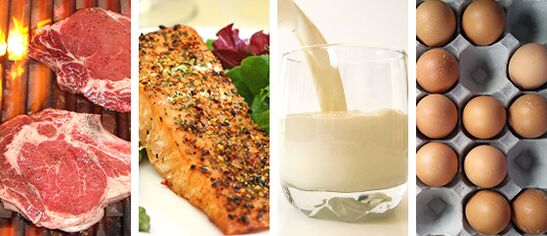
We invite you to thoroughly study the low-carb ketogenic diet and its three options: standard, cyclical and targeted ketogenic diet. This guide includes step-by-step instructions for creating a meal plan and formulas for calculating nutritional needs.
The history of the ketogenic diet dates back several decades, and during this time it has been able to gather many ardent supporters in the bodybuilding subculture. In general terms, the ketogenic diet and its variants are diets enriched in fats and proteins while being extremely low in carbohydrates (usually less than 10% of total macronutrients); With such a diet, the body is forced to use fats as fuel, as glucose reserves are quickly depleted.
For many, the ketogenic diet can be an effective and very correct way to achieve their goals, whether it be building muscle mass, burning fat, developing strength, etc. Although the ketogenic diet is primarily used for fitness and wellness purposes, it is also used in complex epilepsy treatment algorithms.
You might ask, "How is the ketogenic diet different from any other low-carb diet? " To be honest, there aren't many differences. Many believe that such a nutritional system becomes most effective when the body enters a state called "ketosis" and begins to synthesize ketones for subsequent energy generation (hence the name "ketogenic" diet), and such a transition is possible only if severe restriction of carbohydrate intake. However, such a view of the problem is short-sighted, and we will definitely touch on this issue later.

In this guide, we'll take a closer look at the physiological processes that underlie the ketogenic diet, take a look at the existing types/variants of ketogenic diets, learn how to create your own diet, and provide some simple tips on how to whet your appetite for low carbohydrate foods. And, of course, we will answer the most common questions.
What is ketosis?
As mentioned above, the ketogenic diet got its name because the restriction of carbohydrate consumption inherent in this nutritional system can put the body into a state of ketosis, a special physiological state in which the concentration of ketone bodies increases.
Ketone bodies are organic biomolecules, soluble in aqueous media, which are synthesized in the liver from fatty acids when food intake (especially carbohydrates) decreases. Once transported into extrahepatic tissues, these biomolecules can be used as an energy source.
Ketone bodies are constantly synthesized in small quantities in the human body, but normally the concentration of ketones is so low that they are not detected in a urine test. However, when the level of ketone bodies in the blood increases (a condition known as ketonemia), they begin to be excreted in the urine (known as ketonuria); Ketonemia and ketonuria taken together indicate the body's transition into a state of ketosis.
Therefore, the goal of the ketogenic diet is to put the body into a state of nutritional ketosis (not to be confused with pathological ketosis), which ultimately directs the metabolism to use fatty acids and ketone bodies as its main source of energy.
Basic options of the ketogenic diet
In this guide we will explore three main variations of the ketogenic diet: the standard ketogenic diet (SKD), the cyclical ketogenic diet (CKD), and the targeted ketogenic diet (TCD). The type of diet you need is selected purely by trial and error and is largely determined by your priority goals (more details below).
- Standard ketogenic diet– This is the simplest and most basic version of the ketogenic diet. SCD does not involve periods of replenishment of carbohydrate stores, as required by CCD and TKD. It is a linear diet characterized by a constant intake of ketogenic nutrients (moderate to high protein intake, high fat intake and extremely low carbohydrate intake).
- Cyclic ketogenic dietit is a variant of the nutritional system that involves short periods of carbohydrate intake to replenish muscle glycogen reserves after the body's reserves have been completely depleted. The length of time between carbohydrate loads will vary depending on the individual's preferences, training intensity and goals.
- Targeted ketogenic diet- This is the final version of the energy system we are interested in. TKD involves a short-term carbohydrate intake during the training window. The goal of TKD is to flood the body with glucose to improve physical performance without suppressing long-term ketosis.

Which option should I take?
Many factors will influence the choice of type of diet. It is recommended to start with a "run-in period" using a standard ketogenic diet. After a few weeks of running in, you will be able to evaluate how your body reacts to changes in diet, how your physical performance changes and how energetic you are. This will make it easier to decide which diet to use in the long run.
You may also have doubts about which is the best option for losing weight and which is ideal for gaining muscle mass. It must be said that if the total energy value of your diet reaches your goals, the ketogenic diet option will not become a key factor in achieving your goal. You may come across the opinion that CD or TCD is better for people who want to gain muscle mass, since carbohydrates spare protein and stimulate insulin secretion, and standard CD will be the ideal choice for those who want to lose weight, since synthesis of insulin will be more effective. be relatively low. However, these short-term fluctuations in long-distance insulin secretion will not become a deciding factor, unlike the total calorie intake of the diet.
Below is a brief overview of factors to consider when choosing a ketogenic diet option:
- SKD. Ideal for people who lead a predominantly sedentary lifestyle and whose physical performance is not affected by the severe limitation of carbohydrate intake. SKD will also be a great choice for people who don't train too intensely and have high insulin resistance.
- TKD. If you train multiple times a week and notice that your performance worsens with prolonged carbohydrate restriction, it may be worth considering short periods of carbohydrate loading before and possibly after training sessions. Additionally, TKD would be a good choice for people with more training experience who might benefit from a small carbohydrate intake but would not benefit from a heavy carbohydrate load.
- TsKD. Cyclic KD is often called the "most advanced" of all ketogenic diet options. CCD requires a person to patiently go through a trial and error phase, during which the optimal period between carbohydrate loads is sought and the amount of carbohydrates needed on loading days is determined. If you consider yourself an experienced athlete, you actively train all week and even against the background of SCD or TKD you notice a decline in performance, then think about CCD. Perhaps this option will help you get back to work at maximum speed.
Creating your own ketogenic diet
In this section we will talk about how to determine the body's energy and macronutrient needs; these numbers will become the basic guidelines when creating an SCD diet. People who choose CCD or TCD will also need to use the basic calculations for CCD, but with minor adjustments, which I'll talk about later.
In general we can say that those who want to lose weight should stick to the golden rule of a daily deficit of 500 calories, while those who want to increase muscle mass should achieve a surplus of the same 500 calories. However, this is too rough a generalization without taking into account physiological characteristics and other factors. Additionally, if you choose CDD, you will likely have to adjust your calorie intake for a week.
Here is an example of how to calculate macronutrient intake for ADS:
- Determine your energy needs using the daily calorie calculator;
- Daily protein requirement 2 g/kg dry weight: 150 g per day
- Carbohydrate requirement 0. 2-0. 4 g/kg dry weight: 15-30 g per day (in subsequent calculations we proceed from 30 g)
- Since 1 g of protein and carbohydrates contains 4 calories, we have (150 + 30) x 4: 720 calories from proteins and carbohydrates
- We get that this person should get 1280 calories from fat (2000 - 720) and since there are 9 calories in a gram of fat, he should eat about 142 (1280 divided by 9) grams of fat per day.
Therefore, in total, this person's daily diet would include 150 grams of protein, 30 grams of carbohydrates, and 142 grams of fat. We distribute this quantity between meals.
Example of a meal plan consisting of 3 meals:
| Squirrels | Carbohydrates | Fats | |
|---|---|---|---|
| 1st meal | 50 g | 10 g | 48 g |
| 2nd meal | 50 g | 10 g | 47 g |
| 3rd meal | 50 g | 10 g | 47 g |
Example of a food plan consisting of 5 meals:
| Squirrels | Carbohydrates | Fats | |
|---|---|---|---|
| 1st meal | 30 g | 5 g | 29 g |
| 2nd meal | 30 g | 5 g | 29 g |
| 3rd meal | 30 g | 5 g | 28 g |
| 4th meal | 30 g | 5 g | 28 g |
| 5th meal | 30 g | 5 g | 28 g |
Selecting foods for a ketogenic diet
There are no hard and fast rules in the ketogenic diet, just as there are no permitted or prohibited foods. Many believe that the main sources of starch and sugar should not be included in the diet, as this would interfere with the transition of metabolism to the state of ketosis, but in small quantities such products are unlikely to become an obstacle, especially for large people.

Good choices for a ketogenic diet include the following:
- Animal proteins (especially red meat)
- Eggs (whole or just egg whites)
- Fatty dairy products such as cheese, cream, butter, etc.
- Oils, preferably vegetable oils, peanuts, flaxseed, macadamia nuts, olives and some types of coconut
- Nuts and nut butter
- Fibrous vegetables, especially green vegetables, lettuce, broccoli, celery, etc.
During the loading phase of the ketogenic diet, don't limit yourself and include more sources of starches and sugars in your diet, such as fruit.
Design of the Central Control Center
Now let's look at how to integrate carbohydrates into a cycling version of the ketogenic diet.
Those choosing CC should start by carb loading once a week and then adjust the time interval between loading days based on their individual needs. Be prepared to do a lot of experiments, during which you will evaluate how many carbohydrates you ate on the loading day and how you feel in the following days.
The main thing to remember when carb loading is to reduce your fat intake; Don't continue to eat fat in large portions on loading days. But leave your protein intake at the same level (or even increase it to maintain the total calorie content).
Using the macronutrient needs of the previously mentioned 75kg person, here are some basic recommendations for setting up CKD with a loading day depending on your individual insulin sensitivity/carbohydrate tolerance:
- Protein requirement 2 g/kg dry weight: 150 g/day
- For low insulin sensitivity, we calculate carbohydrate intake based on 2-3 g per kg of dry weight
- With normal insulin sensitivity, we calculate carbohydrate intake based on the calculation of 4-5 g per kg of dry weight
- For high insulin sensitivity, we calculate carbohydrate intake based on the calculation of 6-7 g per kg of dry weight
- Now, as before, we simply count the remaining calories, divide by 9 and get the grams of fat that need to be introduced on carb-loading days
An example CDF for people with normal insulin sensitivity and a lean body mass of 75 kg following a restrictive 2000 calorie diet:
- From Monday to Saturday: the nutrient intake must correspond to the previously calculated SKD requirement
- Sunday (carb day, 2500 calories) – 150g protein/300g carbs/78g fat
TCD planning
Now let's look at how to integrate carbohydrates into a targeted version of the ketogenic diet (pre- and post-workout in our example).
As with CCD, when starting TCD, first evaluate how your body reacts to certain amounts of carbohydrates and determine for yourself the optimal time to take them. Remember, when following TKD, you need to eat enough carbohydrates for optimal performance, but don't overdo it. CKD presupposes the presence of periods of replenishment of glycogen stores, while TKD aims only at a short-term increase in energy and performance.
Therefore, if an athlete trains intensely 5 days a week, he should consume carbohydrates before and/or after training on those days. On the remaining days, your nutrient intake should match your SCD calculations.
Calculating nutritional needs during TKD is really no different than SKD; we simply add carbs to the "peri-workout" meal on training days. To illustrate how carbohydrate training should be planned during TKD, here are recommendations for the same 75kg athlete who is cutting, consumes 2000 calories per day, and has some insulin sensitivity/carbohydrate tolerance:
- Protein requirement 2 g/kg dry weight: 150 g/day
- If insulin sensitivity is low, add 0. 5 g of carbohydrates per 1 kg of dry mass to the "pre-workout" meal
- For normal insulin sensitivity add 0. 75 g of carbohydrates per 1 kg of dry mass to the "pre-workout" meal
- If you have high insulin sensitivity, add 1 g of carbohydrates per 1 kg of dry mass to your "pre-workout" meal
- Now we subtract the "extra" calories obtained from carbohydrates and proteins from the daily energy needs and add the missing calories from fats (everything is as before).
A "pre-workout" meal precedes or follows a training session. This means you can randomly distribute the "extra" carbs, as long as they are all consumed within the training window. In general, it is recommended to simply divide the total amount in half and eat them before and after training.
An example of a five-meal TCD diet (on a training day) for a person with 75 kg of lean mass and high insulin sensitivity following a 3000 calorie per mass diet:
| Squirrels | Carbohydrates | Fats | |
|---|---|---|---|
| 1st meal (before training) | 30 g | 40 g | 20 g |
| 2nd meal (after training) | 30 g | 35 g | 20 g |
| 3rd meal | 30 g | 10 g | 30 g |
| 4th meal | 30 g | 10 g | 30 g |
| 5th meal | 30 g | 10 g | 30 g |
Thin tincture of TsKD and TKD
Keep in mind that the above recommendations for carbohydrate intake in cyclical and targeted ketogenic diets are just a starting point. It is impossible to develop a complete, optimal diet that meets the needs of everyone reading this article because there are so many factors to consider.
For this reason, as mentioned above, when mastering advanced versions of ketogenic diets such as TKD and CCD, you need to be careful, thorough and open to experimentation. You'll learn what works best for your body as you go. Always listen to your body and be willing to make the changes it needs.
If you eat 30g of carbs a day and still feel good in the gym, follow this strategy; If you feel more comfortable with two carb-loading days a week, go for it. The recommended carbohydrate intake in this guide is based on experience rather than rigorous scientific research, and you can feel free to tailor it to your individual needs.

And the last tip, especially relevant in relation to TKD. You should reduce the fat percentage in meals that contain a lot of carbohydrates. This does not mean that you should not gain weight at all in the pre-workout meal, you just need to eat a balanced diet and distribute the lion's share of fats between the remaining meals.
Opinion on the role of saturated fats in the ketogenic diet
Starting a ketogenic diet will inevitably increase the percentage of saturated fat in your diet, but that doesn't mean you should rely entirely on saturated fat and ignore your polyunsaturated fat intake.
There is considerable debate about how much saturated fat is considered excessive on a ketogenic diet. Many people who have tried the ketogenic diet insist on large portions of foods such as butter, fatty red meats, full-fat dairy products, etc.
Saturated fats are linked to the production of sex hormones (androgens) in the body of men, and therefore a sharp reduction in their consumption can hardly be called a good idea. However, chronic overuse of saturated fats can lead to increased insulin resistance and other metabolic disorders, so loading the body with these nutrients is also not our plan.
In my opinion, against the background of a ketogenic diet, you can safely increase the percentage of saturated fat in the diet up to 20-30% of total fat. That is, if a person receives 150 grams of fat from food per day, he should try to limit the amount of saturated fat to 30-45 grams per day.
FAQ
Request:Is it possible to include the main sources of carbohydrates in the ketogenic diet menu?
Answer:Some adherents of the ketogenic diet categorically argue that carbohydrate foods should be completely excluded. However, in the case of older people who can eat more carbohydrates and still remain in a state of ketosis, it is possible to allow "mistakes" in the diet in the form of grains, cereals, fruits and starchy vegetables.
Request:Can you eat more protein and less fat on a ketogenic diet?
Answer:Yes, but keep in mind that consuming too much protein will simply lead to increased gluconeogenesis in the liver, which in turn will make glucose the primary fuel source once again.
Request:Should I use ketone test strips to ensure my body has entered a state of ketosis? Should I even care whether I have reached this state or not?
Answer:One should not give too much importance to the presence of ketone bodies in the urine and the formal state of "ketosis". As long as you consume very few carbohydrates in your diet, you will use fats and ketones for the majority of your body's energy needs.
Request:Can I use artificial sweeteners and sugar substitutes while following a ketogenic diet?
Answer:In most cases yes. But remember that some sugar substitutes contain small amounts of fillers such as maltodextrin and dextrose, and if you overindulge in sweeteners, the amount of these fillers in your diet can increase to alarming levels.
Request:Is the ketogenic diet safe for people with high cholesterol?
Answer:Generally safe, especially if most of the fat comes from unsaturated sources. However, if you suffer from chronic diseases, it is advisable to ask your doctor this question and only after his blessing to undertake a ketogenic diet.
Request:Should plant fiber be included in the total calorie intake of the diet?
Answer:Plant fibers are not listed as "net carbohydrates" on food labels. However, plant fiber, like any nutrient, contains calories.
Request:After high carb meals (during carb loading), my stomach bloats and I fall into a drowsy state. What should I do?
Answer:You can try increasing the frequency of your meals and distributing carbohydrate-rich foods more evenly. Or try to eat most of your carbohydrates in the evening, when after eating you can finally relax and tune into passive rest.
Request:When I first tried the ketogenic diet, I felt out of place. This is fine?
Answer:Many people feel exhausted within a few weeks, especially if their diet was previously based on carbohydrate-rich foods. However, if your performance doesn't improve over time, try TCD or CDT and see if it helps fix the problem.
Conclusion
I hope this in-depth look at the ketogenic diet has taught you a lot and provided useful information to help you take your first steps. Remember, you need to be open to experimentation and listen carefully to the signals your body sends.
Many people follow low-carb, high-fat diets with great success, while others feel terrible on a ketogenic diet and are unable to function or function normally. If you find that you belong to the second group, don't try to force your body and stick to a ketogenic diet for the sake of the diet itself.
Ultimately, your diet should do two things: Help you achieve your fitness and health goals without interfering with your daily life. You don't have to sacrifice one for the other, although many people do just that when setting new goals. It doesn't matter how good a diet looks on paper and in theory if you can't stick to your plan. Do what works best for you and stay the course for the long haul. This is where the secret of success lies.

















